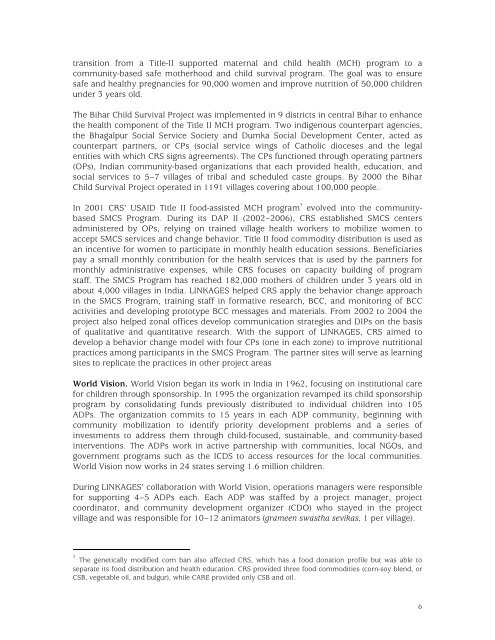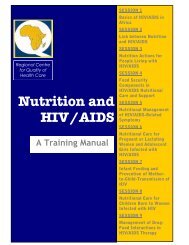LINKAGES India Final Report (1997â2004) - Linkages Project
LINKAGES India Final Report (1997â2004) - Linkages Project
LINKAGES India Final Report (1997â2004) - Linkages Project
You also want an ePaper? Increase the reach of your titles
YUMPU automatically turns print PDFs into web optimized ePapers that Google loves.
transition from a Title-II supported maternal and child health (MCH) program to a<br />
community-based safe motherhood and child survival program. The goal was to ensure<br />
safe and healthy pregnancies for 90,000 women and improve nutrition of 50,000 children<br />
under 3 years old.<br />
The Bihar Child Survival <strong>Project</strong> was implemented in 9 districts in central Bihar to enhance<br />
the health component of the Title II MCH program. Two indigenous counterpart agencies,<br />
the Bhagalpur Social Service Society and Dumka Social Development Center, acted as<br />
counterpart partners, or CPs (social service wings of Catholic dioceses and the legal<br />
entities with which CRS signs agreements). The CPs functioned through operating partners<br />
(OPs), <strong>India</strong>n community-based organizations that each provided health, education, and<br />
social services to 5–7 villages of tribal and scheduled caste groups. By 2000 the Bihar<br />
Child Survival <strong>Project</strong> operated in 1191 villages covering about 100,000 people.<br />
In 2001 CRS’ USAID Title II food-assisted MCH program 3<br />
evolved into the communitybased<br />
SMCS Program. During its DAP II (2002–2006), CRS established SMCS centers<br />
administered by OPs, relying on trained village health workers to mobilize women to<br />
accept SMCS services and change behavior. Title II food commodity distribution is used as<br />
an incentive for women to participate in monthly health education sessions. Beneficiaries<br />
pay a small monthly contribution for the health services that is used by the partners for<br />
monthly administrative expenses, while CRS focuses on capacity building of program<br />
staff. The SMCS Program has reached 182,000 mothers of children under 3 years old in<br />
about 4,000 villages in <strong>India</strong>. <strong>LINKAGES</strong> helped CRS apply the behavior change approach<br />
in the SMCS Program, training staff in formative research, BCC, and monitoring of BCC<br />
activities and developing prototype BCC messages and materials. From 2002 to 2004 the<br />
project also helped zonal offices develop communication strategies and DIPs on the basis<br />
of qualitative and quantitative research. With the support of <strong>LINKAGES</strong>, CRS aimed to<br />
develop a behavior change model with four CPs (one in each zone) to improve nutritional<br />
practices among participants in the SMCS Program. The partner sites will serve as learning<br />
sites to replicate the practices in other project areas<br />
World Vision. World Vision began its work in <strong>India</strong> in 1962, focusing on institutional care<br />
for children through sponsorship. In 1995 the organization revamped its child sponsorship<br />
program by consolidating funds previously distributed to individual children into 105<br />
ADPs. The organization commits to 15 years in each ADP community, beginning with<br />
community mobilization to identify priority development problems and a series of<br />
investments to address them through child-focused, sustainable, and community-based<br />
interventions. The ADPs work in active partnership with communities, local NGOs, and<br />
government programs such as the ICDS to access resources for the local communities.<br />
World Vision now works in 24 states serving 1.6 million children.<br />
During <strong>LINKAGES</strong>’ collaboration with World Vision, operations managers were responsible<br />
for supporting 4–5 ADPs each. Each ADP was staffed by a project manager, project<br />
coordinator, and community development organizer (CDO) who stayed in the project<br />
village and was responsible for 10–12 animators (grameen swastha sevikas, 1 per village).<br />
3<br />
The genetically modified corn ban also affected CRS, which has a food donation profile but was able to<br />
separate its food distribution and health education. CRS provided three food commodities (corn-soy blend, or<br />
CSB, vegetable oil, and bulgur), while CARE provided only CSB and oil.<br />
6

















